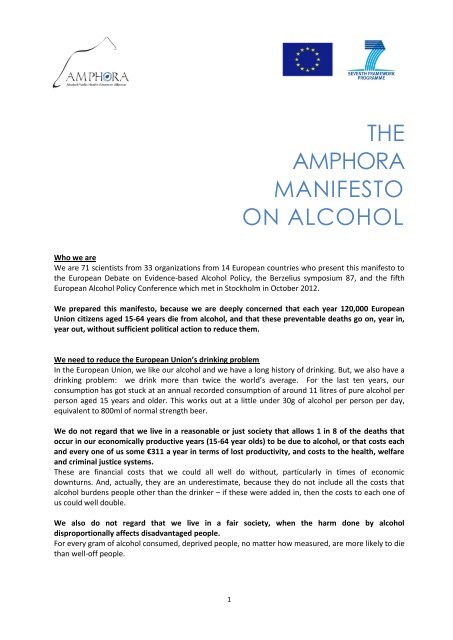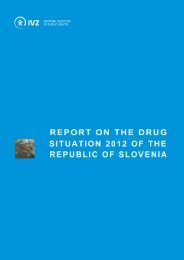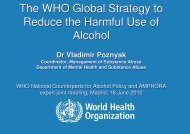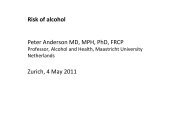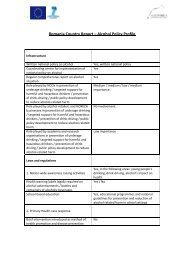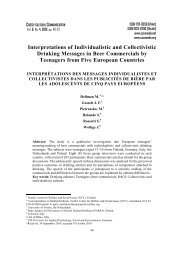THE AMPHORA MANIFESTO ON ALCOHOL - amphoraproject.net
THE AMPHORA MANIFESTO ON ALCOHOL - amphoraproject.net
THE AMPHORA MANIFESTO ON ALCOHOL - amphoraproject.net
You also want an ePaper? Increase the reach of your titles
YUMPU automatically turns print PDFs into web optimized ePapers that Google loves.
<strong>THE</strong><strong>AMPHORA</strong><strong>MANIFESTO</strong><strong>ON</strong> <strong>ALCOHOL</strong>Who we areWe are 71 scientists from 33 organizations from 14 European countries who present this manifesto tothe European Debate on Evidence-based Alcohol Policy, the Berzelius symposium 87, and the fifthEuropean Alcohol Policy Conference which met in Stockholm in October 2012.We prepared this manifesto, because we are deeply concerned that each year 120,000 EuropeanUnion citizens aged 15-64 years die from alcohol, and that these preventable deaths go on, year in,year out, without sufficient political action to reduce them.We need to reduce the European Union’s drinking problemIn the European Union, we like our alcohol and we have a long history of drinking. But, we also have adrinking problem: we drink more than twice the world’s average. For the last ten years, ourconsumption has got stuck at an annual recorded consumption of around 11 litres of pure alcohol perperson aged 15 years and older. This works out at a little under 30g of alcohol per person per day,equivalent to 800ml of normal strength beer.We do not regard that we live in a reasonable or just society that allows 1 in 8 of the deaths thatoccur in our economically productive years (15-64 year olds) to be due to alcohol, or that costs eachand every one of us some €311 a year in terms of lost productivity, and costs to the health, welfareand criminal justice systems.These are financial costs that we could all well do without, particularly in times of economicdownturns. And, actually, they are an underestimate, because they do not include all the costs thatalcohol burdens people other than the drinker – if these were added in, then the costs to each one ofus could well double.We also do not regard that we live in a fair society, when the harm done by alcoholdisproportionally affects disadvantaged people.For every gram of alcohol consumed, deprived people, no matter how measured, are more likely to diethan well-off people.1
What needs to be done to reduce the European Union’s drinking problemWe regard the arguments as compelling that all European consumers should be adequatelyinformed about the risks of alcohol, including legally required health information labelling,determined by ministries of health.To put it simply, the more we consume over a lifetime, the more we consume on an occasion and thegreater the number of such occasions, the greater the risk of negative health outcomes stacking up.Averaging it all out, the lifetime risk of dying from an alcohol-related cause increases pretty much in astraight line with the amount of alcohol consumed, is similar for both men and women, and there is nolevel without risk. The lifetime risk of dying from an alcohol related cause is about 1 in 100 whendrinking one large glass of wine (175ml) a day. This risk increases 14 fold to about one in seven whendrinking a 750ml bottle of wine a day.We regard the arguments as compelling that all European consumers should be adequately warnedthat alcohol causes multiple diseases and medical conditions, including cancer, through legallyrequired warning labels on all beverage containers, determined by ministries of healthAlcohol causes more than 200 different diseases and conditions. It is an intoxicant causing intentionaland unintentional injuries, interpersonal violence, homicide, suicide and drink–driving fatalities; itincreases the likelihood of risky sexual behaviour, sexually transmitted diseases and HIV infection; it isa potent teratogen being a cause of low birth weight, cognitive deficiencies and foetal alcoholdisorders; it is neurotoxic to brain development, leading to structural changes in the hippocampus inadolescence and reduced brain volume in middle age; it is a dependence-producing drug, similar toother substances under international control; it is an immunosuppressant, increasing the risk oftuberculosis, HIV/AIDS and pneumonia; it is classified by the International Agency for Research onCancer as a carcinogen causing cancers of the mouth, larynx, oesophagus, liver, colo-rectum andfemale breast; although it is overwhelmingly toxic to the cardiovascular system, light to moderate useof alcohol can be protective for ischaemic diseases, an effect, though, that is wiped out by just oneheavy drinking occasion per month; there is also an increased risk of cardiovascular diseases withheavy drinking.We regard the evidence as compelling that the price of alcoholic beverages should be increasedimmediately through taxation throughout the European Union, and for all products including beerand wine.In their joint brief for the 2011 UN high level meeting on non-communicable diseases, both the WorldEconomic Forum and the World Health Organization concluded that the first of three ‘best buys’ toreduce alcohol related harm was to make it more expensive. In the overwhelming majority of casewherever and whenever it has been studied, when alcohol becomes cheaper, more is consumed andmore harm ensues. When it becomes more expensive, less is consumed and less harms result. And,heavy drinkers and people dependent on alcohol also drink less when the price goes up. Alcohol taxesare good in the sense that they reduce the need for employment taxes and create much neededgovernment revenue that can be used to offset all the other stresses facing the European Union.We regard the arguments as compelling that a minimum price per gram of alcohol should beaccepted as a legitimate alcohol policy measure in EU member states, and for all products includingwine.A minimum price per gram of alcohol is an equitable way of reducing harm and gets over the problemof selling alcoholic beverages that are cheap relative to their alcohol strength, and thus oftenconsumed by young people to get drunk. Canadian jurisdictions have introduced minimum pricingsystems for some years, contributing to public health, without frictions arising in business or trade.Jurisdictions of the United Kingdom have introduced or plan to introduce a minimum price per gram ofalcohol.2
We regard the common arguments put forward against price increases as invalid.Concern is expressed that if the price of legal alcohol goes up, then more people will brew or distiltheir own alcohol, or try to get hold of illegal alcohol; whilst this is clearly important in some parts ofthe world, it is not so important in the European Union. When prices differ between neighbouringjurisdictions, consumers do cross nearby borders to purchase cheaper alcohol. But, it is important tonote that sometimes responses to price differentials can make matters worse. For example, in 2004,when Estonia joined the European Union, Finland dropped alcohol taxes by one third as a disincentivefor consumers to buy cheaper alcohol from Estonia. However, the consequence was that between2003 to 2005, deaths for liver diseases caused by alcohol increased by 52%, and government revenuesdropped by 29%. The more socially deprived were disproportionately burdened. Finland has sinceraised taxes and consumption and harm have dropped. Thus, lowering excise duties to solve crossbordershopping does not seem to be the solution. Rather, it would seem better to have lowerindicative levels for private import, as the high amount that consumers can bring in for privateconsumption can be a threat to jurisdictions that have higher excise duties to protect public health.We regard the evidence as compelling that alcohol should be less easy to get in a whole variety ofways.This was the second of the three ‘best buys’ put forward by the World Economic Forum and the WorldHealth Organization. When alcohol becomes easier to get, more alcohol is consumed and more harmresults; when alcohol becomes more difficult to get, less is consumed and less harm results. So,reducing the number of alcohol outlets, and the days and hours of alcohol sales, saves lives. Wherealcohol is placed in supermarkets also matters. If it is easy to put it in the supermarket trolley, more isput in. If it is more difficult, less is put in.We regard the evidence as compelling that all forms of commercial communications on alcoholshould be banned.This was the third of the three ‘best buys’ put forward by the World Economic Forum and the WorldHealth Organization. When it is studied, the greater the exposure, the greater non-drinkers are likelyto start to drink, and the greater the consumption of existing drinkers. Even simply watching a onehour movie with a greater number of drinking scenes, or viewing simple advertisements can doublethe amount drunk over the hour’s viewing period. Most commercial communications are now do<strong>net</strong>hrough social media outlets, and, so, bans need to apply to them. Self-regulatory codes do not work.Even if an advertisement is pulled after airing, it is too late and the advertisement often lives on,copied in social media.We regard that other measures can reduce the harm done by alcohol.There are a lot of other things that can be done that make it easier for drinkers to drink less. Forexample, implementing tough drink driving laws reduces the amount drunk; the physical and socialdesign and management of drinking premises can reduce the amount drunk on each occasion. Settinga minimum age for buying alcohol seems important, although, in some countries, much less importantthan expected - simply because, as young people themselves report, they do not seem to have anydifficulty in getting alcohol because often minimum age purchase laws are not enforced.We regard the evidence as compelling that some initiatives need to be reframed so as to make adifference to how much is actually drunk.One of these is education to children and young people. Young people are, of course, important - thehuge structural brain changes that take place during adolescence need to be protected; and, the laterthe age that young people start to drink, the better their educational achievement, and the less likelythey are to end up dependent on alcohol later in life. But, unfortunately, the evidence is consistent insaying that, for the most part, current educational programmes targeted at young people do notnormally change their drinking behaviour in any consistent or sustained way. This is perhaps notsurprising given the environment in which they live – many young adults, parents and the middle-aged3
hardly set a good example. In addition, young people are exposed to all sorts of advertising,particularly through social media and electronic communication outlets, encouraging non-drinkers tostart drinking and existing drinkers to drink more. Education policy could benefit from incorporating aconceptual shift from influencing attitudes to affect behaviour to looking at the influence of behaviouron attitudes, as well as greater support for educational programmes that involve parents.We regard the evidence as compelling that advice and treatment should be better delivered to thosewho drink too much or who are dependent on alcohol, closing the gap between need and advice andtreatment.Whatever polices or programmes are implemented, many drinkers will still get into problems withalcohol. For these people, providing advice and treatment to cut down drinking improves health, andto an enormous degree, if enough help can be provided. The problem is that only a tiny proportion ofthose who would benefit from advice and treatment actually get it, and, for too many people, thereare too many lost years between the development of a problem, and the offer of some help to dealwith it.We are concerned that our governments are not doing enough to reduce the harm done by alcohol.By their own admission, many countries themselves say that they have been doing the wrong things.Over the five years 2006-2010, according to a 2012 World Health Organization report, areas of policythat got stronger in European Union countries included more education and public campaigns, andareas that did not get stronger or got weaker included pricing and advertising. This is the wrong wayround to what might have made a difference.We are troubled that too many governments and governmental bodies do not relate to the alcoholindustry, producers and retailers, in a mature and effective wayToo often, it seems to us, conversations with the alcohol industry are about ineffective strategies, suchas simple education or self-regulation of advertising, that are not going to make a difference topeople’s health. We are convinced that it would be more helpful if the conversations addressed whatthe industry itself could concretely do to lessen the health burden. One obvious measure is to removebillions of grams of alcohol from the market, not to be consumed by anyone. This can be achieved byreducing the alcohol strength of beverages, in the same way that food and beverage industries arereducing salt content.Finally we come back to where we started – it concerns us deeply that 120,000 preventable deathsare occurring each year amongst European Union citizens aged 15-64 years.We look to political courage to rectify this, and it is not difficult to address. Already, World EconomicForum and the World Health Organization have shown us the way to go with their best buys: increaseprice, reduce availability, and ban advertising. And, some jurisdictions are showing courage – forexample, Scotland by introducing a minimum price per gram of alcohol and England and Walespreparing to do so, and Finland by drafting a highly effective advertising law.Preparation of this manifestoThis manifesto was drafted by the coordinating team on behalf of the chief scientists of the FP7 cofinanced<strong>AMPHORA</strong> project (http://www.<strong>amphoraproject</strong>.<strong>net</strong>/). All scientists in the project have hadthe opportunity to comment on the manifesto.The views expressed in this document do not necessarily reflect the views of the organisations towhich the <strong>AMPHORA</strong> scientists belong.A video version of this manifesto can be seen at: www.<strong>amphoraproject</strong>.<strong>net</strong>4


